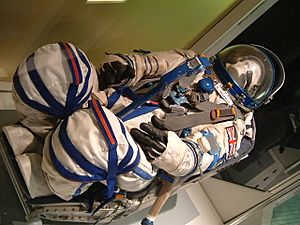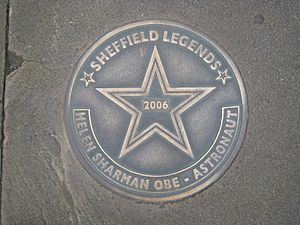Helen Sharman facts for kids
Quick facts for kids
Helen Sharman
|
|
|---|---|

Sharman in 2015
|
|
| Born |
Helen Patricia Sharman
30 May 1963 Sheffield, West Riding of Yorkshire, England
|
| Alma mater | University of Sheffield (BSc in 1984) Birkbeck, University of London (Ph.D. in 1987) |
| Occupation | Chemist |
| Space career | |
| Project Juno cosmonaut {{ }} | |
|
Time in space
|
7d 21h 13m |
| Selection | 1989 Juno |
| Missions | Soyuz TM-12, Soyuz TM-11 |
|
Mission insignia
|
|
| Signature | |
 |
|
Helen Patricia Sharman (born 30 May 1963) is a British chemist and astronaut. In May 1991, she made history by becoming the first British person to travel to space. She was also the first Western European woman in space and the first woman to visit the Mir space station.
Contents
Early Life and Career
Helen Sharman was born in Sheffield, England. After finishing school, she went to the University of Sheffield and earned a degree in chemistry in 1984. She later earned a PhD from Birkbeck, University of London in 1987.
As a chemist, she first worked for a company called GEC. Later, she worked for Mars, the famous chocolate and candy company. Her job was to study the science of chocolate flavors. Because of this, the press gave her the fun nickname "The Girl from Mars."
Becoming an Astronaut
A Life-Changing Advertisement
One day in 1989, while driving home from work, Sharman heard an ad on the radio. It said, “Astronaut wanted. No experience necessary.” This was for a mission called Project Juno, a joint project between the United Kingdom and the Soviet Union. The goal was to send a British astronaut to the Soviet Mir space station.
Sharman applied for the position, competing against almost 13,000 other people. On November 25, 1989, she was selected live on television to be Britain's first astronaut.
Training in Russia
To prepare for her space mission, Sharman moved to Star City, Moscow, in Russia. She spent 18 months there in difficult training. She had to learn Russian, study advanced mechanics, and get used to the feeling of being in space.
Sharman later said she was very excited about the training. She explained, “It wasn’t so much going to space as the training that appealed... It was a way out of the rat race.”
Project Juno almost didn't happen because the British companies sponsoring it couldn't raise enough money. However, the Soviet Union decided to pay for the mission to maintain good international relations.
Mission to the Mir Space Station
On May 18, 1991, Sharman launched into space aboard the Soyuz TM-12 spacecraft. She was joined by Soviet cosmonauts Anatoly Artsebarsky and Sergei Krikalev. She was 27 years old, making her one of the youngest people to ever fly in space.
Her mission lasted for eight days, with most of the time spent on the Mir space station. While in space, Sharman performed several experiments. She conducted medical and agricultural tests and took photographs of the British Isles from orbit. She also used an amateur radio to talk to schoolchildren back in Britain.
For her journey, she carried a few special items: a "space passport" in case she landed in a different country, a butterfly brooch from her father, and a photo of Queen Elizabeth II.
On May 26, 1991, she returned to Earth safely.
Records Broken
Helen Sharman broke several important records during her mission.
| Record | Date |
|---|---|
| First British cosmonaut | 25 November 1989 |
| First British person in space | 18 May 1991 |
| First Western European woman in space | 18 May 1991 |
Life After Space
After her historic flight, Sharman wrote an autobiography called Seize the Moment in 1993. She also wrote a children's book, The Space Place, in 1997. She has worked to communicate science to the public through radio and television shows.
In 2015, she became the Operations Manager for the Department of Chemistry at Imperial College London. She continues to give talks about her spaceflight and her love for science.
In a 2020 interview, Sharman shared her thoughts on extraterrestrial life. She said, "aliens exist, there are no two ways about it." She suggested that it's possible they are so different from us that "we simply can't see them."
Awards and Recognition
Helen Sharman has received many awards for her achievements. In 1992, she was appointed an Officer of the Order of the British Empire (OBE) by the Queen. In 2018, she was appointed a Companion of the Order of St Michael and St George (CMG) for her work in science. She has also received medals from Russia for her part in the space mission.
A funny moment happened in 1991 when she was chosen to light the ceremonial flame at the Summer Universiade, a major sporting event in her hometown of Sheffield. While running, she tripped and the flame in her torch went out. She kept running and, despite the torch being unlit, the large ceremonial flame at the stadium still ignited perfectly.
Many schools have honored Sharman by naming school houses or science buildings after her. This shows how she has inspired many young people, especially women, to get involved in science and technology.
See also
 In Spanish: Helen Sharman para niños
In Spanish: Helen Sharman para niños



